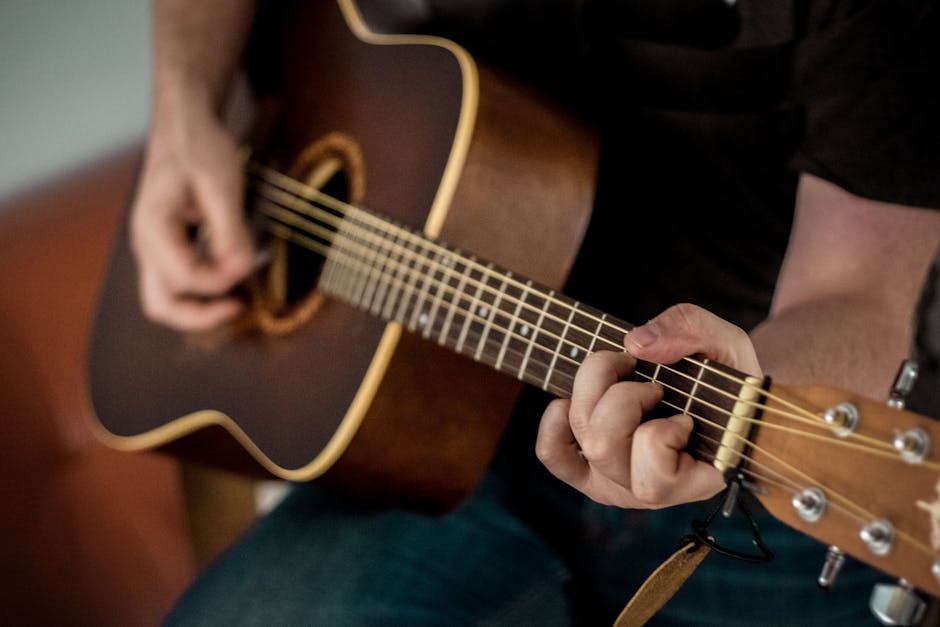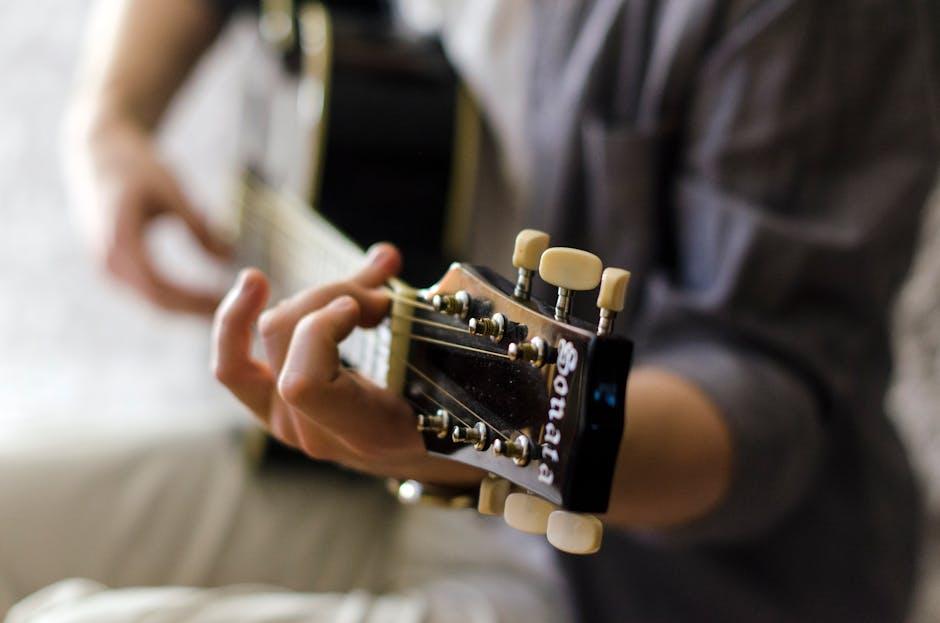Are you tired of feeling like a musical noob while everyone else shreds on their guitars with ease? Fear not, my fellow six-stringed warriors, for I am here to guide you on your quest to becoming a guitar-the-best-instrument-allow-me-to-enlighten-you/” title=”Why is Guitar the Best Instrument? Allow Me to Enlighten You”>master of music theory. Grab your guitar and get ready to dive into the weird and wonderful world of notes, scales, and chords – because trust me, it’s gonna be a wild ride. So sit back, relax, and prepare to have your mind blown as we uncover the essential tips every guitarist needs to know to conquer music theory like a rockstar.
Contents
- 1 Embracing the Basics of Music Theory for Guitarists
- 2 The Importance of Understanding Scales and Modes
- 3 Navigating Chord Progressions and Their Construction
- 4 Developing a Subtle Ear: The Art of Identifying Intervals
- 5 Applying Music Theory to Improve Improvisation Skills
- 6 The Role of Music Theory in Composition and Songwriting
- 7 Enhancing Creativity on the Guitar Through Theoretical Knowledge
- 8 FAQs
- 9 Rock on!
Embracing the Basics of Music Theory for Guitarists
So you’ve decided to take the plunge and dive into the world of music theory for guitarists. Congratulations! You’re about to embark on a journey that will forever change the way you look at your instrument. But before you get overwhelmed with all the complex terminology and concepts, let’s start by embracing the basics.
First things first, let’s talk about the musical alphabet. Just like the regular alphabet, but with more sharps and flats. Think of it as the secret code that unlocks the mysteries of chords and scales. Memorize those notes and you’ll be well on your way to becoming a guitar wizard.
Next up, let’s chat about intervals. No, not the space between guitar practice sessions (although that’s important too). Intervals are the building blocks of music, the distance between two notes that create harmonies and melodies. Wrap your head around these bad boys and you’ll be shredding like a pro in no time.
And finally, let’s touch on scales. Ah, the scales. The bane of every beginner guitarist’s existence. But fear not! Learn your major and minor scales like the back of your hand, and you’ll be flying up and down the fretboard in no time. Who knew that a few simple notes could hold the key to unlocking your full musical potential?
The Importance of Understanding Scales and Modes
Do you know your scales and modes like the back of your hand? If not, buckle up and get ready for a wild ride through the world of music theory! Understanding scales and modes is like having a secret decoder ring for unlocking the mysteries of music.
Imagine being able to effortlessly navigate your way through any piece of music, confidently knowing which notes and chords will work together harmoniously. It’s like being a musical superhero, swooping in to save the day with your knowledge of scales and modes.
So grab your guitar, piano, or whatever instrument strikes your fancy, and dive headfirst into the wonderful world of scales and modes. With a little practice and a lot of determination, you’ll be wowing your friends and family with your newfound musical prowess in no time.
Remember, music theory doesn’t have to be boring or intimidating. Embrace the challenge, have fun with it, and soon enough you’ll be a scales and modes master, ready to conquer any musical obstacle that comes your way. Rock on!

Alright folks, buckle up because we’re about to dive deep into the wacky world of chord progressions and their construction. So grab your metaphorical hard hats because things are about to get rocky!
First things first, let’s talk about the basics of chord progressions. Think of them like the ingredients in a recipe – each chord is a different flavor that, when combined in just the right way, creates a delicious musical dish. Just like how you wouldn’t throw a bunch of random ingredients together and call it a meal, you can’t just slap a few chords together and call it a progression. It takes finesse, trial and error, and maybe a pinch of musical genius.
Now, let’s break it down even further. Chord progressions are made up of, you guessed it, chords! These bad boys are the building blocks of your progression, so it’s important to choose them wisely. Here are a few tips to keep in mind when constructing your chord progression:
- Variety is the spice of life: Don’t just stick to the same old chords – mix it up and surprise your audience.
- Transition like a boss: Smooth transitions between chords are key to keeping your progression flowing like a well-oiled machine.
- Play with tension and release: Add some tension with dissonant chords and release it with consonant ones for an emotional rollercoaster ride.

Developing a Subtle Ear: The Art of Identifying Intervals
So you’ve decided to embark on the journey of developing a subtle ear, eh? Well buckle up, because identifying intervals is no walk in the park. It’s like trying to distinguish between different shades of black – challenging, but oh so rewarding.
First off, let’s talk about the good old unison. Aka the “well, duh” interval. It’s like when someone tells you that water is wet – no surprise there. But hey, at least it’s a good warm-up for your ear, right?
Now let’s dive into the world of seconds and thirds. They’re like the distant cousins of unison – a little trickier to identify, but still manageable if you listen closely. Think of them as the side characters in a movie – they might not steal the show, but they definitely add some flavor.
And finally, we have the big boys - fourths, fifths, and beyond. These intervals are like the high-stakes poker games of the music world. One wrong move and you’re lost in a sea of dissonance. But fear not, with enough practice and a keen ear, you’ll soon be able to spot these intervals from a mile away.

Applying Music Theory to Improve Improvisation Skills
When it comes to improving your improvisation skills, applying music theory can be a game changer. It’s like adding a secret ingredient to your musical stew, making it a masterpiece that leaves everyone wanting seconds.
First off, understanding scales is key. It’s like knowing the different flavors on a spice rack – mix and match them to create a unique melody that will have your audience begging for more. Play around with major, minor, pentatonic, and blues scales to add some spice to your improvisation.
Next, chord progressions are your best friend. Think of them as the foundation of your musical building. Experiment with different progressions like I-IV-V or ii-V-I to create a solid structure for your improvisation.
Lastly, don’t forget about rhythm. It’s like the heartbeat of your music, keeping everything in sync. Play around with syncopation, accents, and different time signatures to add some flair to your improvisation and keep your audience grooving along with you.
The Role of Music Theory in Composition and Songwriting
When it comes to creating banging tunes, music theory is like the secret sauce that makes all the difference. It’s like knowing the recipe to the perfect dish, except in this case, the dish is a killer song that will have everyone hitting repeat.
Music theory helps you understand the building blocks of music - notes, chords, scales, rhythms – and how they all fit together like puzzle pieces. It’s like being a musical architect, designing a masterpiece that will have listeners grooving along without even realizing why.
With music theory in your toolkit, you can unleash your creativity in ways you never thought possible. You’ll be able to experiment with different chord progressions, modulations, and harmonies, creating a musical rollercoaster that takes your listeners on a journey they’ll never forget.
So next time you’re struggling to come up with a killer hook or bridge, remember that music theory is your best friend. Embrace it, learn it, and use it to take your songwriting to the next level. Who knows, you might just come up with the next chart-topping hit!
Enhancing Creativity on the Guitar Through Theoretical Knowledge
So you’ve mastered the art of strumming and picking on your guitar, but you’re itching to take your creativity to the next level. Well, look no further because we’ve got just the solution for you – theoretical knowledge!
By delving into the world of music theory, you’ll uncover a treasure trove of tools and techniques that will help you unlock new creative possibilities on the guitar. From understanding chord progressions to experimenting with different scales and modes, theoretical knowledge will open up a whole new dimension to your playing.
And don’t worry, you don’t have to be a musical genius to reap the benefits of theoretical knowledge. With a little bit of study and practice, you’ll be amazed at how quickly you can start incorporating these new ideas into your playing. So grab your guitar, brush up on your theory, and get ready to dazzle your friends with your newfound creativity!
So why wait? Dive headfirst into the world of music theory and watch as your guitar playing reaches new heights of creativity and innovation. Who knows, you might even discover a new favorite chord or scale along the way. The possibilities are endless – so grab your guitar and get ready to rock!
FAQs
Why is music theory important for guitarists?
Well, music theory is like the instruction manual for your guitar playing. It helps you understand how and why certain chords and scales work together, giving you the tools to write your own music and improvise like a rock star.
What are some key music theory concepts every guitarist should know?
Think of music theory as your secret weapon. You’ve got your basic scales, chords, and intervals, but also dive into more advanced topics like chord progressions and modes. The more you know, the more creative and versatile you’ll become as a guitarist.
How can I apply music theory to my guitar playing?
It’s all about practice, baby! Start by learning the basic scales and chords, then experiment with different combinations and progressions. Don’t be afraid to make mistakes – that’s all part of the learning process. And remember, even the greatest guitarists had to start somewhere.
Are there any shortcuts to mastering music theory for guitarists?
Sorry to burst your bubble, but there’s no magic pill for mastering music theory. It’s all about putting in the time and effort to really understand the concepts. But hey, if you love playing guitar as much as I do, it won’t feel like a chore – it’ll be a labor of love.
What resources are available to help me learn music theory for guitar?
From online tutorials and books to music theory apps and courses, there’s a wealth of resources out there to help you on your journey to music theory mastery. Find what works best for you and dive in headfirst – your guitar playing will thank you for it!
Rock on!
Congratulations, you’ve made it through our crash course in mastering music theory for guitarists! Now go forth and conquer the world of music with your newfound knowledge. Whether you’re strumming some sweet chords or shredding a face-melting solo, remember that music theory is the secret sauce that will take your playing to the next level. So keep practicing, keep experimenting, and keep rocking out! And never forget: when in doubt, just play it loud!



